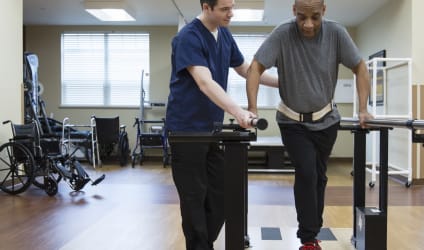How to Become a Physical Therapist
Editor & Writer
Editor & Writer
Reviewer
Editor & Writer
Editor & Writer
Reviewer
www.bestcolleges.com is an advertising-supported site. Featured or trusted partner programs and all school search, finder, or match results are for schools that compensate us. This compensation does not influence our school rankings, resource guides, or other editorially-independent information published on this site.
Turn Your Dreams Into Reality
Take our quiz and we'll do the homework for you! Compare your school matches and apply to your top choice today.
- It takes 7-8 years to become a physical therapist.
- PTs must earn a doctorate in physical therapy and obtain state licensure.
- Physical therapists can earn great salaries and have strong job prospects.
Becoming a physical therapist (PT) requires a significant investment of time, energy, and money. These healthcare professionals must earn a doctor of physical therapy (DPT) degree in addition to state licensure.
However, those who meet these requirements can look forward to great salaries and specialize in pediatrics, women's health, geriatrics, and other concentrations. Interested in becoming a physical therapist? Below, learn more about the steps it takes to join this field, including education and licensure requirements.
What Is Physical Therapy?
Physical therapy is a healthcare profession that uses exercise, manual therapy, and other techniques to help clients with injuries or chronic discomfort improve their movement quality and manage pain.
But it's also so much more than that.
"Our job is about the whole person, not just their injury or impairment. A degree in physical therapy will prepare you for dealing with the mental and emotional aspects of patient care as well as the physical," said Reggie Evants, PT, DPT. "We're in the business of improving a person's quality of life — not just the bend of their knees."
What Does a Physical Therapist Do?
So where do physical therapists work and what does a day in their life look like? Physical therapists work in hospitals, home health, sports, nursing care, outpatient care, and other settings. A typical day in the life of a physical therapist usually includes:
-
Reviewing clients' medical histories -
Meeting with clients, evaluating them, observing their movements, and determining treatment needs -
Creating individualized treatment plans with recovery steps and measurable goals -
Providing ongoing, hands-on care and education -
Managing administrative paperwork (like patient progress reports) -
Depending on the setting, communicating with families and collaborating with other care providers
"I always encourage prospective students to do some research to make sure the ins and outs of this job are a good fit. Interview a few PTs. Shadow in clinics. Work as an aide in a clinic or two before you take the leap."
Featured Online Physical Therapy Programs
Learn about start dates, transferring credits, availability of financial aid, and more by contacting the universities below.
6 Steps to Become a Physical Therapist
Now that we've covered what a PT does, we'll walk you through the step-by-step process of physical therapist schooling and how to become one.
Step 1: Earn a Bachelor's Degree
It's very common for future PTs to get a bachelor's degree in a related field, like:
But you don't have to major in one of those areas. If you don't, you must pick up the required prerequisites for admission to a DPT program. Requirements typically include courses in:
- Anatomy
- Physiology
- Biology
- Physics
- Psychology
- Statistics
"A non-science degree can sometimes make you a more interesting candidate and well-rounded applicant. Looking back, I wish I'd taken classes in business or pursued a dance degree because I work with dancers in my practice."
Step 2: Complete Observation Hours and Grad Exams
Most reputable DPT programs require applicants to complete observation hours as volunteers or interns before applying. The number of hours required varies by program.
You may also need to take the GRE, though not all programs require it.
Step 3: Earn a Doctor of Physical Therapy
All states require prospective physical therapists to hold a doctorate in physical therapy in order to qualify for licensure.
As a prospective physical therapy student, you should only consider courses of study with programmatic accreditation from the Commission on Accreditation in Physical Therapy Education (CAPTE). CAPTE focuses exclusively on physical therapy and provides a seal of approval for high-quality DPT programs.
Step 4: Pass the NPTE and Obtain State Licensure
Every physical therapist has to pass the National Physical Therapy Examination before becoming licensed.
Keep in mind that staying licensed requires ongoing continuing education. As a general rule, you'll need to complete continuing education credits every year or so — how many depends on which state you live in.
Step 5: Consider a Residency Program and Board Certification
A certification or residency program can help you progress in your career. The American Physical Therapy Association (APTA) offers board certification in ten major areas:
- Sports
- Pediatrics
- Geriatrics
- Orthopaedics
- Oncology
- Women's health
- Cardiovascular and pulmonary
- Clinical electrophysiology
- Neurology
- Wound Management
It's important to understand that committing to a residency program may require some careful planning: They can be pretty stressful and are rarely well-paid.
Step 6: Get a Job as a Physical Therapist
With your DPT and state license in hand, you'll be able to compete for most roles in the field.
While you can leverage your physical therapist schooling, residency training, and certifications to improve your salary potential, there aren't a lot of opportunities for upward mobility beyond your role as a PT.
Some may go on to become practice managers who supervise others and run operations at their healthcare facilities. Others may decide to open and manage their own clinics.
How Long Does It Take to Become a Physical Therapist?
Physical therapist schooling typically takes between 7-8 years, including four years of a bachelor's degree and three years of graduate school. Additionally, gaining field experience and pursuing licensing and certification may add to this timeline.
Some accelerated programs may take as few as six years.
Is Becoming a Physical Therapist Worth It?
We spoke to several experienced PTs about everything you need to know before becoming a physical therapist.
1. It's worth it.
"It's absolutely, 100% worth it. Not only is physical therapy personally rewarding and professionally challenging, it's incredibly needed throughout the world. With our large aging population, PTs are highly in demand — ensuring job stability, security, and flexibility. I feel very fortunate that my degree means I will always be able to find work. It's also a great feeling to have a set of skills, which can be so helpful to so many people."
2. It's a big financial investment.
"Take some time to consider your debt-to-income ratio. There are many careers in healthcare where you can make an impact without taking on such a financial burden. At the same time, I got into the profession because of my passion for others — and I would not change my decision."
3. It's a lot of responsibility.
"This job comes with its share of pressure: It's on you to help your patients make optimal functional recoveries while keeping them safe and preventing future injury. Physicians and surgeons are counting on you to help their patients recover. Insurance reimbursements are decreasing over time. A seemingly endless amount of documentation is required on a daily basis. Anytime you're dealing with the health of another person, there's a great deal of responsibility involved."
4. It's emotionally demanding.
"It's an incredibly fulfilling experience to help patients regain their mobility. But it can be extremely draining at the same time. I was prepared for the physical aspects of the job but not the emotional ones. I ended up leaving direct patient care for a non-clinical career."
5. It's important to be a little business-savvy.
"I wish I had known how important marketing and basic business skills were going to be as I progressed down my career path as a practice owner. PT schools do a great job teaching the craft, but they don't prepare you to run a business, market yourself, or network with a community of professionals."
Featured Online Physical Therapy Programs
Learn about start dates, transferring credits, availability of financial aid, and more by contacting the universities below.
Frequently Asked Questions About How to Become a Physical Therapist
What degree do you need to be a physical therapist?
To become a licensed physical therapist in the U.S., you must earn a doctoral degree in physical therapy from an accredited program.
DPT programs involve in-class curriculum as well as clinical training.
How much does a physical therapy degree cost?
According to CAPTE, the average DPT program in 2021-2022 cost between $69,828 and $120,656 in total tuition. Keep in mind that individual costs can vary widely by program. You should also factor in the cost of a bachelor's degree. The NPTE also costs $485 to take.
The true program cost for a DPT also considers room and board, relocation, transportation, and other associated fees. Online students can often save on some of these extra costs.
Is a physical therapist a doctor?
Physical therapists are doctors, but they aren't physicians. Instead of attending medical school, physical therapist schooling requires a doctor of physical therapy degree. Because they hold a doctorate, they can use the title "doctor."
In medical settings, many professionals can use the title doctor without being physicians. PTs meet high standards to practice in their field. In addition to earning a doctorate, physical therapists must pass a national exam and apply for a state license to practice.
Do physical therapists make good money?
While the cost to become a PT is a significant financial investment, these professionals do earn high salaries. According to the BLS, as of May 2022, licensed physical therapists earned a median annual wage of $97,720. The top 10% of earners in the field made more than $128,830.
The highest-paying industry for physical therapists is outpatient care centers, where physical therapists make a mean annual wage of $118,800. The top-paying state for these professionals is California, where PTs earn an average annual salary of $114,230.
Note: The insights on this page — excluding school descriptions — were reviewed by an independent third party compensated for their time by BestColleges. Page last reviewed March 16, 2024.







